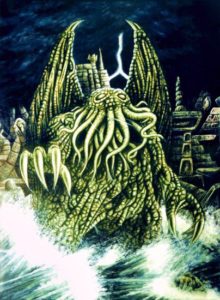We are currently in the Holocene epoch, and many of us have heard about calls to name the current era (from the industrial revolution) the Anthropocene (which dates back to at least the industrial revolution, if not before): a period when humans change the essential nature of the planet through their activities (primarily via the production of greenhouse gases).
But what comes after the Anthropocene? Some sort of Mad Max style wasteland perhaps?
Donna Haraway (2015) proposed that there will be a new epoch, the “Chthulucene” where refugees from environmental disaster (both human and non-human) will come together .
This is a time when humans will try to live in balance and harmony with nature (or what’s left of it) in “mixed assemblages”. She notes that in naming this epoch the elder gods she refers are not ones of HP Lovecraft’s horror stories, but elder gods that are harmonious earth and nature deities such as Gaia, Pachamama and Raven. If there are tentacles, there are tentacles of connection, as the remaining humans realize that living with nature and being a part of the ecosystem is important for our survival. Rather than in the current epoch where many humans consider themselves to be outside of nature, with certain political leaders denying that humans are capable of substantively changing the environment , and are thus are not trying to rein in their impacts.
Credit: BendoKiwi (via creative commons)
If there is to be a Chthulucene, where humans truly try to live in sustainable way in harmony with other species and ecosystems, really depends on how long the Anthropocene lasts, and whether human impacts can be reversed. We may be reaching a tipping points where instead of Haraway’s vision of a harmonious Chthulucene we have a Cthulhucene (note the subtle difference in spelling) where humanity shall be devoured by a enormous horror of our own making. As Haraway notes, we are all in this together , humans, ecosystems and all, and the need to come together (as far as the environment is concerned) has never been more important.
P.S. The author lost 1d6 sanity points while writing this article and may be currently found in the Arkham Retreat for Environmental Mad Scientists.
References
Haraway, D. (2015). Anthropocene, Capitalocene, Plantationocene, Chthulucene: Making Kin. Environmental Humanities 6: 159-165

I just taught this in my grad seminar, glad to see it get airtime on SFS 🙂